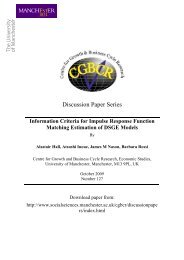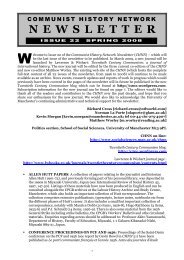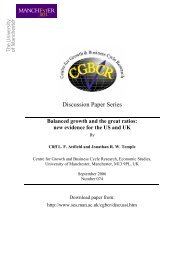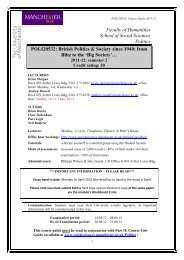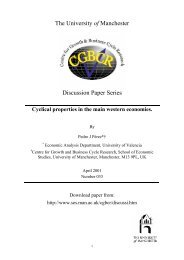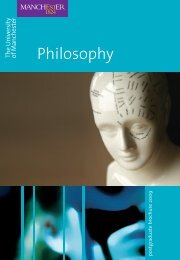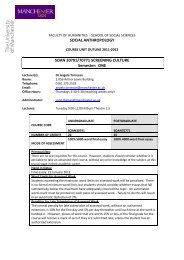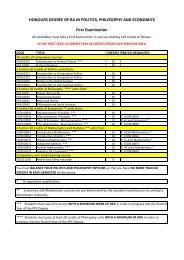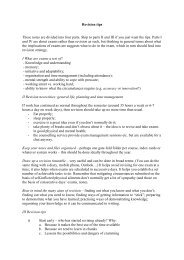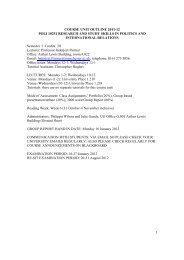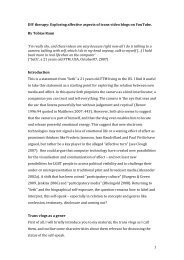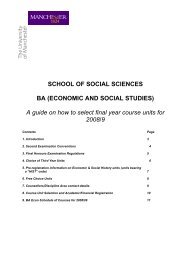second year course outlines 2012-2013 - School of Social Sciences ...
second year course outlines 2012-2013 - School of Social Sciences ...
second year course outlines 2012-2013 - School of Social Sciences ...
You also want an ePaper? Increase the reach of your titles
YUMPU automatically turns print PDFs into web optimized ePapers that Google loves.
Heidegger’s view might be criticised by questioning his claim that the ready-to-hand is prior<br />
to the<br />
present-at-hand, by arguing that the phenomena he unearths do not make intentionality<br />
possible,<br />
but in fact presuppose it, or by arguing that it neglects the role <strong>of</strong> the body in skilled activity.<br />
The Reading<br />
This is a classic section from Heidegger’s seminal work Being and Time. The tone is very<br />
different<br />
to the reading from last week. Heidegger’s fundamental philosophical interest is in the nature<br />
<strong>of</strong><br />
the meaning <strong>of</strong> being. How are the different ways <strong>of</strong> being—the what <strong>of</strong> things—<strong>of</strong> entities<br />
made<br />
manifest to us? This signals a departure from Husserl. Indeed, Heidegger is <strong>of</strong>ten interpreted<br />
as<br />
presenting a position deeply at odds with Husserlian phenomenology. He does, however,<br />
refer to<br />
his own work as ‘phenomenology’ and his conception <strong>of</strong> phenomenology as the disclosing <strong>of</strong><br />
‘that<br />
which shows itself’ as it shows itself, is clearly closely related to Husserl’s ‘science <strong>of</strong><br />
phenomena’.<br />
On Heidegger’s view, the fact that we inhabit a world is so fundamental to us (Heidegger<br />
refers to<br />
us as ‘Dasein’—literally ‘being-there’), that he calls our mode <strong>of</strong> being ‘being-in-the-world’. In<br />
this<br />
section, Heidegger coins lots <strong>of</strong> terminology (especially in the difficult §14) and it is easy to<br />
get lost<br />
in this. Nevertheless, one can still get some sense <strong>of</strong> the phenomena (the world, or<br />
environment<br />
and the entities within it) that Heidegger is keen to elucidate. Try to keep a focus on the idea<br />
that<br />
Heidegger is concerned with the question <strong>of</strong> how the world, and the entities within it, is<br />
presented<br />
to us in every day, practical experience. Although there is important material throughout the<br />
reading, much <strong>of</strong> the vital claims are to be found in §§15-16, so you might want to skip the<br />
lengthy<br />
§17 and the obscure §18.<br />
Questions to Consider:<br />
1. In §15 Heidegger introduces the notion <strong>of</strong> the ‘ready-to-hand’ which is encountered in a<br />
special<br />
kind <strong>of</strong> awareness ‘circumspection’. This is distinguished from the merely ‘present-at-hand’<br />
which is the object <strong>of</strong> theoretical inquiry and investigation. How does Heidegger characterise<br />
the ready-to-hand?<br />
2. Towards the end <strong>of</strong> §15, Heidegger claims that the ready-to-hand is prior to the presentathand.<br />
What do you think he means by this, and does he give adequate reasons?<br />
3. In §16 Heidegger claims that it is when equipment becomes unusable that ‘the world<br />
announces itself’. What does he have in mind? Do you think that he is right?<br />
20<br />
Lecture 7 (Week 8): Perception III – perceptual constancy (Merleau-Ponty)<br />
Required Reading:<br />
Merleau-Ponty, M. 1945. Phenomenology <strong>of</strong> Perception, translated by C. Smith. London:<br />
Routledge, 1962, Part 2, Chapter 3, 'The Thing and the Natural World', pp.299-317 [S]<br />
Also available at www.archive.org<br />
Recommended Reading:<br />
54



